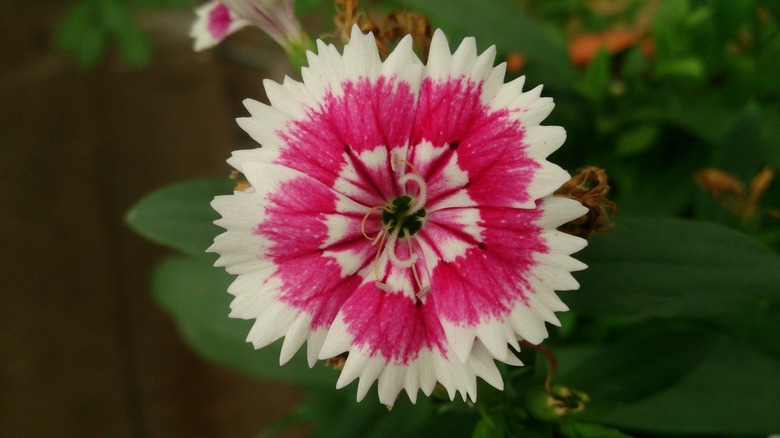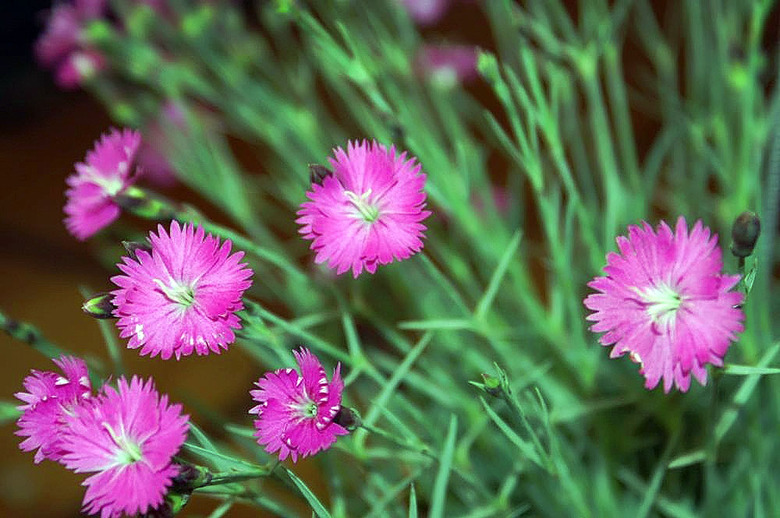How To Keep Dianthus Blooming
There are approximately 300 species and 27,000 cultivars of the flowering plants known collectively as dianthus (Dianthus spp.). Also referred to by the common name "pinks," because their frilly petals resemble fabric that has been cut with pinking shears, these plants are a staple bedding plant in cottage gardens and cut-flower bouquets.
Dianthus has fragrant flowers that come in almost every imaginable shade of pink, purple, magenta, red, yellow and white. There are also bicolor cultivars on the market.
Dianthus plants may be annuals, biennials or perennials depending on the cultivar. Perennial varieties are hardy in U.S. Department of Agriculture plant hardiness zones 3 to 9.
When Does Dianthus Bloom?
Native to Europe and Asia, dianthus plants bloom for several weeks in late spring and early summer. For example, China pinks (Dianthus chinensis, zones 6 to 9) typically bloom from April to June, while carnations (Dianthus caryophyllus, zones 6 to 9) bloom in June or July. Cheddar pinks (Dianthus gratianopolitanus, zones 4 to 8) are in bloom in May and June.
Some dianthus cultivars will bloom from spring until the first frost in early fall. They include sweet William (Dianthus barbatus, zones 3 to 9), which is a short-lived perennial dianthus often grown as a biennial.
Growing Dianthus Plants
Dianthus plants flower best when they are grown in full sun, which means they receive at least six hours of direct sunlight every day. However, many varieties of dianthus do not handle heat and humidity well and appreciate afternoon shade on hot summer days.
While dianthus can handle different types of soil, they perform best in moist soil that has a neutral or slightly alkaline pH.
Tip
For best results, grow dianthus in well-drained, slightly alkaline soil and provide good air circulation to avoid diseases.
Well-drained soil as well as air circulation are key to avoid root rot, stem rot and other diseases that can kill dianthus plants. For this reason, it is best not to apply mulch around your dianthus.
Keeping Dianthus Blooming
In addition to providing proper soil and light conditions, you can keep your dianthus plants reblooming in late summer by fertilizing them and deadheading the dianthus flowers.
Fertilizer
One way to encourage your dianthus plants to rebloom is by feeding them every six to eight weeks during the growing season with all-purpose liquid formula. Light feeding is sufficient.
Deadheading
Deadheading, which simply means removing the spent flowers, can also extend dianthus bloom time. Dried-up flowers should be removed promptly if you want the plant to bloom again.
Tip
Removing spent dianthus flowers as soon as they dry up can encourage the plants to rebloom again in the summer.
When they begin to fade in the summer and are pruned all the way down to their basal foliage, dianthus plants often produce flowers again within a few weeks. Pruning individual flowers can take a lot of time, but shears can be used to efficiently prune many dianthus plants at once.
References
- University of Wisconsin-Madison Division of Extension: Dianthus 'Bath's Pink'
- North Carolina State Extension: Dianthus
- University of New Hampshire Extension: What is the Best Way to Deadhead Perennials?
- Colorado State University Extension: Darling Dianthus
- Better Homes & Gardens: How to Plant and Grow Dianthus
- Missouri Botanical Garden: Dianthus chinensis
- Missouri Botanical Garden: Dianthus barbatus
- Missouri Botanical Garden: Dianthus caryophyllus 'Clarion'
- Missouri Botanical Garden: Dianthus gratianopolitanus

